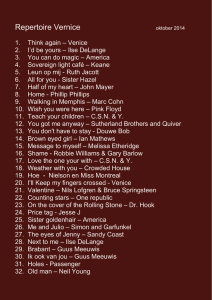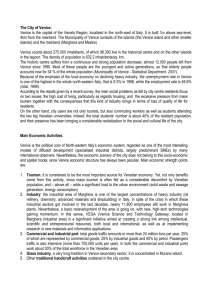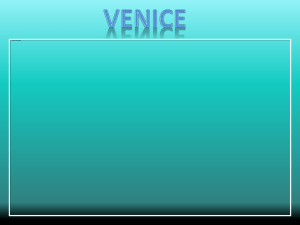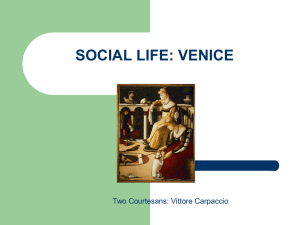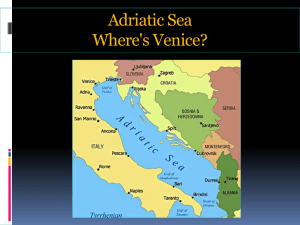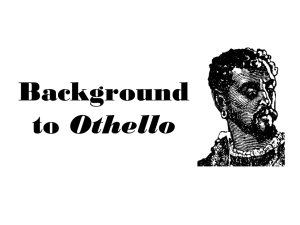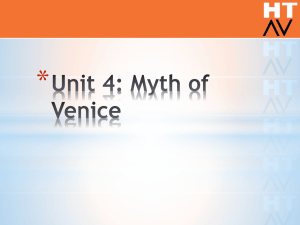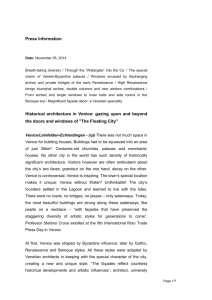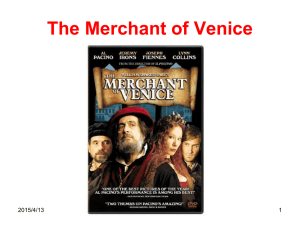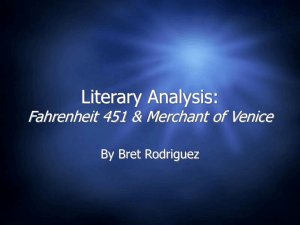The Myth of Venice: Renaissance Lecture
advertisement
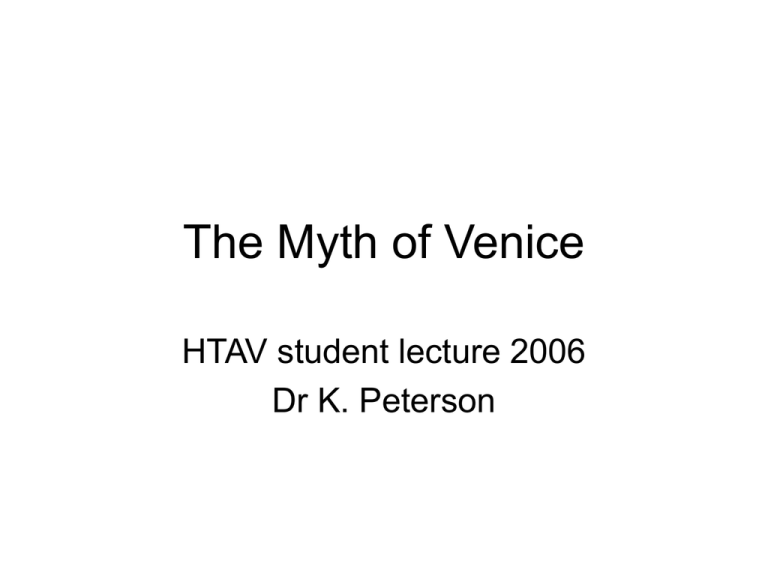
The Myth of Venice HTAV student lecture 2006 Dr K. Peterson The way Venice presented itself as La Serenissma to the world. The phrase ‘myth of Venice’ is modern but the ideas it encompases were clearly articulated in Renaissance Venice and had their origins even earlier. The Venetian self concept can be summed up with words like:Republican/ the home of liberty Harmonious/stable Just Pious Productive/prosperous/wealthy Beautiful Benevolent/cosmopolitan ‘Venice’s reputation for beauty, religiosity, liberty, peacefulness and republicanism modern scholars call the “myth of Venice”. This catalogue of attributes constituting the myth is not just the creation of latter-day scholars, however: the Renaissance Venetians acknowledged the same myth in their visual arts, musical lyrics, poetry, official and popular history, humanist works and, above all, in ritual and pageantry.’ Edward Muir, Civic Ritual in Renaissance Venice, p. 21 ‘ Over the course of several centuries Venice has refined a portrait of itself that responded to and exploited historical circumstance and vicissitude’ David Rosand, Myths of Venice, p. 1 Martin da Canale, C 13th ‘Venice, which is today the fairest and pleasantest in the world, full of beauty and of all good things’ Pier Tafur (Spaniard ) ‘The city has no wall, nor any fortress, except those two castles which enclose the harbour, since its defence lies in the sea.’ 1430s Marin Sanudo _ Venice built ‘more by divine than human will’. Medieval engraving: The City in the Sea The Porta della Carta The arch, built by Doge Foscari, linking the treasury of San Marco and the Ducal Palace. Identify the significant elements C1400, Marco Polo’s departure, an illumination Crowned kingdom above kingdoms O the universe, where of Christianity In holy baptism Your equal in the world is not to be found You are in the world a living phoenix That renews itself and never changes form Just as your custom Seems to me transformed into what I speak …. I speak the truth, I speak of what I love, That Troy was never so powerful Nor Rome in ancient times As Venice, and now it is clearly shown. … The great lion has one paw in the meadow, The other on the mountain, the third on the plain, The fourth is set in the sea So as to make a wide passage Anon early 1400s Crowned kingdom above kingdoms O the universe, where of Christianity In holy baptism Your equal in the world is not to be found You are in the world a living phoenix That renews itself and never changes form Just as your custom Seems to me transformed into what I speak …. I speak the truth, I speak of what I love, That Troy was never so powerful Nor Rome in ancient times As Venice, and now it is clearly shown. … The great lion has one paw in the meadow, The other on the mountain, the third on the plain, The fourth is set in the sea So as to make a wide passage Anon early 1400s Mansuetti, Miracle at the Bridge Part of the Miracle of the Holy Cross, Carpaccio 1496+ Healing of the Possessed Man Gentile Gellini, Miracle of the Bridge of San Lorenzo 1500 Bassano, The Consignment of the Sword (1580s) Celebrates events in 1170s when the Doge mediated between the Holy Roman Emperor, Frederick Barbarossa and the Pope ` Gentile Bellini, Procession in Piazza San Marco 1496 Lion of St Mark, 1516, (painting on canvas) Vittore Carpaccio. Originally painted for the Magistrates of the Treasury, whose officers were in the Rialto. Later hung in the Doge’s Palace. Allegory of the League of Cambrai,Palma il Giovane, 1590 Veronese: Apotheosis of Venice (Triumph of Venice Jacopo Tintoretto, The Voluntary Subjugation of the Provinces to Venice, 1578-85 Some comments by modern historians: ‘In response to diplomatic failures, the Venetians retreated into the comfort of the myth, which seemed to grow…in an inverse proportion to the decline of Venice’s actual political power.’ Muir, Civic Ritual Venetian narrative painters had to satisfy their self-conscious public in two ways. Renaissance Venetians needed to see historical truths verified by depiction in paint, as Fortini Brown has so persuasively shown in her work on the pictorial cycles in the Venetian scuole. But they also needed narrative paintings visually to reinforce and to confirm the political, economic and social strength and authority of the Serenissima. Francis Ames-Lewis, “The image of Venice in Renaissance narrative painting”, from New Impressions of Venetian Renaissance Painting (1994) pp.17-29 Just yesterday evening there was a man in front of the bishop who said he was a marchesco (a follower of St Mark and therefore of Venice) and marchesco he would die, for he did not want to live any other way; so the Bishop had him hanged.. it is impossible that the king can keep these lands with such countrymen living. Machiavelli, the Florentine secretary and sometime critic of Venice, commenting in Verona in 1509 on the way many of the popolani preferred Venetian rule to that of the feudal nobles who regained control of the city under the League of Cambrai. Benedetto Dei (Florentine writer and information disseminator, client of the Medici) 1472 denied that Venice was a stable, just republic, the false and futile claims, that the state and the Signoria of Venice has ruled for a thousand years without ever changing or making any innovations – you are simply scattering your counterfeit money for those who know no better. …Venice has undergone more revolutions and innovation and bloodshed than have the four most violent and warlike cities in Italy. Pius11, who tried and failed to get the Venetians to agree to a crusade against the Turks, admitted thatVenetian gov.t: within the memory of our fathers Venetian justice was rated very high. yet in 1465 he wrote: What do fish care about law? As among brute beats aquatic creatures have the least intelligence, so among human beings the Venetians are the least just and the least capable of humanity and naturally for they live on the sea and pass their lives in the water… not so much companions of men as of fish and crowds of marine monsters. Lament of the Venetians. Anonymous, German woodcut 1509
